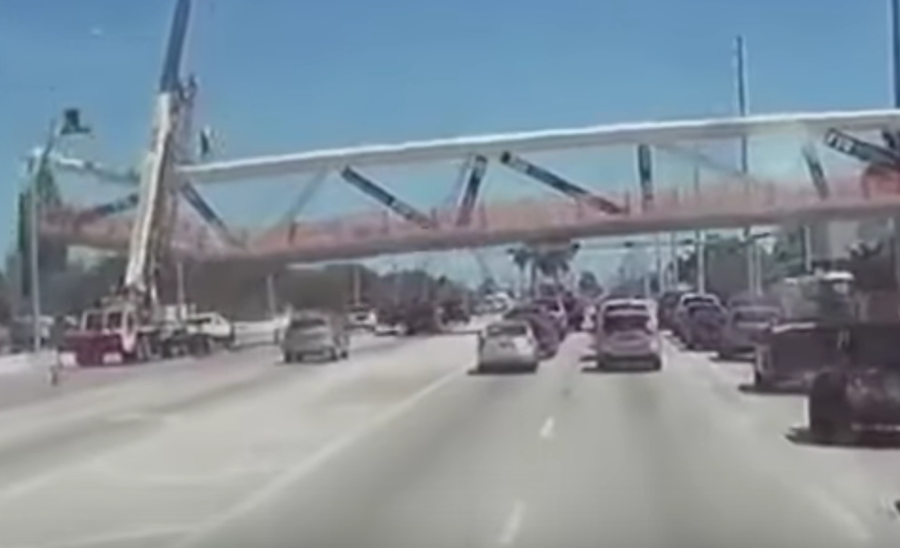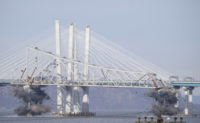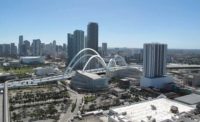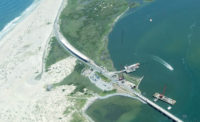One of the first lawsuits filed over the pedestrian bridge failure at Florida International University that killed five motorists and one worker pulls together details from the unusual amount of public information and images available about what occurred. It suggests that post-tensioning triggered the failure that brought down the structure.
According to the lawsuit, the March 15 collapse, over a road separating the campus from the city of Sweetwater, occurred while a crew was post-tensioning bars in a diagonal member at the north end of the concrete truss that was the bridge’s main element. The post-tensioning compressed the diagonal so that it overstressed a joint in the top chord, the lawsuit claims, triggering hinge failure at a connection in the lower chord and resulting in the catastrophic failure of the rest of the 174-ft-long structure.
 |
| Enlarged dash cam video with letters pointing to connections that allegedly failed during post-tensioning operation on truss. |
Post-tensioning that modifies the stresses in a structure is inherently risky and should be performed “in the absence of traffic,” the lawsuit claims.
Filed on behalf of a student, Emily Joy Panagos, whose car was crushed at the accident site, the complaint in state court in Miami draws heavily on video of the collapse, a voice message about cracks in the structure that were deemed superficial at that time by the engineer of record and design drawings in the design-build joint venture’s proposal.
The lawsuit also draws on statements by the National Transportation Safety Board that a post-tensioning crew was at work at the bridge's north end at the time of the collapse. NTSB had said in a statement that “workers were adjusting tension on the two tensioning rods located in the diagonal member at the north end of the span when the bridge collapsed.” They “had adjusted one rod” and were “working on the second rod when the span failed and collapsed.”
A crane is positioned at that location, the dash cam video shows, and a worker appears to dangle briefly in a harness as the structure beneath gives way.
As the companies involved in the project and their insurers and attorneys organize for the investigation and for other lawsuits, it is likely that new ideas about what caused the collapse will be proposed. Another scenario, for example, could be suggested in which the top-chord connection is found to be improperly designed or constructed so that it was vulnerable when the post-tensioning was carried out.
The signature pedestrian bridge, built with state-of-the-art techniques, was intended to make history and increase safety at the crossing.
But then the 950-ton truss structure came crashing down in seconds, killing five motorists waiting at a traffic signal.
___________________________________________________
Theories Outrun Reliable Facts in Florida Bridge Collapse
Before Collapse, Bridge Builders Dismissed Concerns About Cracks
NTSB Joins Probe of Fatal Florida Bridge Collapse
___________________________________________________
The university had touted the unusual pedestrian bridge, with its open concrete truss design and its rapid placement, just five days before.
In the days since, countless people—including readers of ENR—who have viewed the dash cam footage of the falling bridge and reviewed design drawings have formulated their own opinions about why it happened. Among the possible causes and contributing factors cited are the concrete cracking in the main span’s north end and the design-builder’s use of the time-tested Accelerated Bridge Construction (ABC) methodology. The tightening of tendons just before the collapse is also widely suspected of playing a key role.
Defendants Named in Lawsuit
Panagos, who seeks $15,000 in damages for physical and emotional injuries, names as defendants the two companies in the design-build joint venture, Munilla Construction Management LLC (MCM), Miami, and FIGG Bridge Engineers, Tallahassee.
Two other subcontractors were named as defendants but they could not be reached Friday for comment on the lawsuit or what role they played in the project.
FIGG Bridge Engineers said in a statement that it is “aware that a lawsuit has been announced regarding the pedestrian bridge accident. Our priority focus continues to place sympathies for the victims at the forefront of our thoughts. FIGG Bridge Engineers will work diligently with authorized investigators in an earnest ongoing effort to determine what led to the accident and what can be done to ensure that nothing like it happens again."
MCM officials could not be reached for comment specifically about the lawsuit. They have posted a statement on the corporate website noting that “our family’s thoughts and prayers go out to everyone affected by this terrible tragedy." The release goes on to say “we will conduct a full investigation to determine exactly what went wrong.”
NTSB crews have removed the bridge’s components to an FDOT warehouse for further testing and investigation, NTSB stated.
This article was corrected March 27 to reflect the fact that the lawsuit was not the very first one filed over the Florida tragedy, according to the dates in the court record. This article was corrected March 28 to show motorists were waiting at a traffic signal, not a street light.






Post a comment to this article
Report Abusive Comment